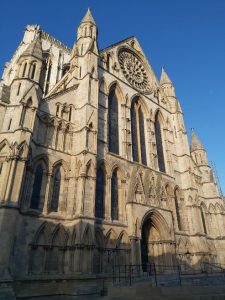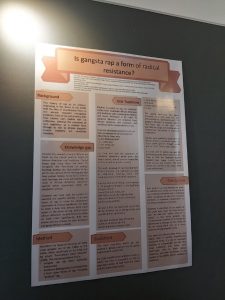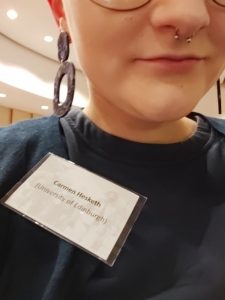Presenting a paper
Student Ambassador reports back from presenting her paper.
In late February 2020, I was very fortunate to have the opportunity to present a paper at ‘From Margins to Centre? An Undergraduate Conference on BAME, LGBTQ+, Women’s and Disability History’ at The University of York. I had never attended a conference before and had no idea how to write and present a paper, so this was a really valuable experience for me to learn a lot of new skills!

York Minster.
I decided to travel to York the day before and stay overnight in a hostel so I could see the city, as I heard that it’s very beautiful. The rumours were certainly true! I had a fabulous time at the York Castle Museum, which seemed to go on forever (perfect for a museum enthusiast like me) with exhibitions on the history of the body, life in the trenches during the First World War, and Britain in the 1960s, to name a few. I particularly enjoyed the body exhibition because it reminded me of a course called ‘The Making of the Modern Body’ which I studied in my second year, and I found the fashion history exhibit very interesting because it showed how ideals of beauty have changed over time.
I arrived at the University of York campus early in the morning to listen to the many panel discussions taking place, which included papers from undergraduate students from all over the UK. Some of the topics presented included the role of West Africans in the French Resistance during the Second World War, attitudes towards the disabled poor in 16th Century Norwich and the problems with the terminology ‘Islamic Art’ within the field of History of Art.

Lola Moutel-Davesne’s poster on ‘Is gansta rap a form of radical resistance?’
The talent of the panellists and the breadth of interesting topics that were presented were amazing, many of which I had never explored in my own research! During the lunch break, many undergraduate students also presented posters on their research, including another of Edinburgh’s history students, Lola Moutel-Davesne, who presented a poster on her dissertation research relating to gangsta rap and black activism in the US.

The all-important speaker’s name badge.
At the end of the day, it was time for me to present my paper. My panel discussion was all about how history can inform us about the identities of marginalised groups, and my talk in particular was about the history of bioengineering (the industry which designs and constructs artificial limbs) and the experiences of those who used artificial limbs in Edinburgh since the First World War. I had learned about bioengineering history through my summer internship at the Lothian Health Services Archive which is part of the University of Edinburgh’s Centre for Research Collections. This role had made me realise my passion for disability history and why I am now studying the history of HIV and AIDS in Scotland as part of my undergraduate dissertation.
I’d be lying if I said that presenting my paper was not a terrifying experience, but I am so proud of myself for doing it and hopefully raising awareness for further research into the field of disability history. Here’s hoping I can be involved in other conferences in the near future!



